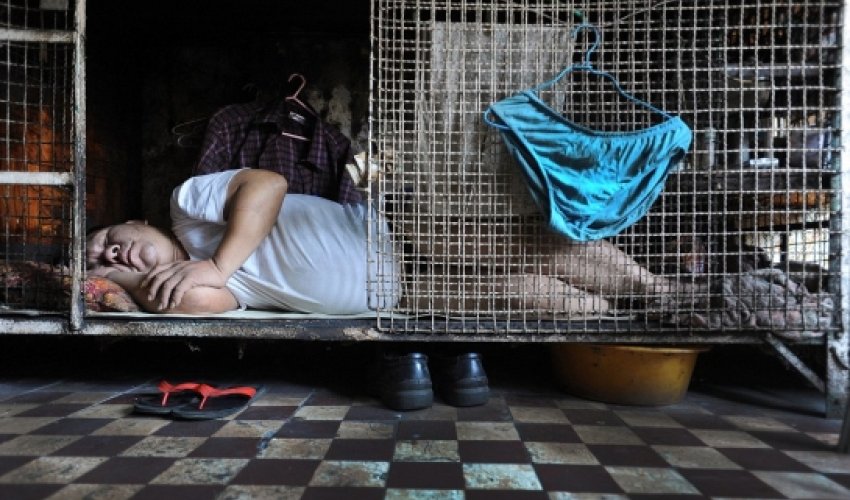Hong Kong's 'caged dogs' - PHOTO

Hong Kong's forgotten 'caged dogs' pay about HK$1,500 a year (£117) to live in a city whose small size and high population pushes the rent on even a tiny flat far out of the reach of its poorest residents.The poverty-stricken people keep their clothes and photos of loved ones next to filthy blankets in their cages, which measure 6ft long and between 2 1/2 ft and 3ft wide and are stacked on top of each other.Some of them cannot stretch their legs out straight and are forced to sleep curled up in a ball.British-born photographer Brian Cassey, who lives in Cairns, Australia, is the latest to document residents of shocking cage homes who are known locally as 'caged dogs'.He found one of the illegal iron and timber shanties perched on the rooftop of a 12-storey apartment block in the downtown district of Kowloon, on the peninsula opposite the main city centre on Hong Kong Island.'The atmosphere inside is hot, dark, intense and unfriendly', he said. 'As I first arrived in the corridor outside, I could hear the landlord inside yelling at the residents; I beat a retreat and returned later.'With a population of more than 7 million, about the same as London, the wealthy former British colony has an area of just 426 square miles which puts prices at a premium. A small one-bedroom apartment costs about HK$16,000 (£1,240) a month.The caged homes began in the 1950s and 1960s when a baby boom and an influx of Chinese migrants saw Hong Kong's population soar by more than a million.But there were just a few thousand cages until the 1990s, when the estimated number soared to a peak of 100,000 in 1997.Last year the government estimated there are 177,000 people living in highly inadequate housing in Hong Kong, but because so many of the cage homes are run illegally it is impossible to say how many of that number were cages.According to the most recent official figure in 2007, 53,000 people were living in the mesh boxes.One cage-dweller, Wong Tat Ming, 57, said his home is too small for him to stretch out fully, forcing him to sleep curled up into a ball.Many of the residents feel making a cage their home is better than living on the street. One, Roger lee, 61, said: 'I have been here for three years now and before this I was in another cage home. 'I've been on the public-housing waiting list for many years, but I'm single so have no hope.'The government says there are more than 220,000 people on the waiting list for public housing, about half of whom are single individuals, and the average wait is almost three years.Some illegally tenanted buildings were evicted recently, but only five out of 100 of the tenants were reportedly offered public housing.Homelessness in Hong Kong was once rare, but many hundreds now live in doorways, under overpasses, and in tunnels.Sze Lai-Shan works for Hong Kong's Society for Community Organisation, which visits 1,000 cage-dwellers a year and campaigns for their living standards to be improved.She told MailOnline: 'If you run a cage home you need to apply for a licence but people are now setting them up without licences and running them illegally, so the government doesn't have an accurate figure on how many there are.'We're finding more and more illegal cage homes and the cost of living in them is rising. The average rent is about 1,500 Hong Kong dollars (£117) a year. If the landlord is kind they might charge $1,000, and that's for 15 or 18 square feet.'We're trying to put pressure on the government to increase the supply of public housing and push the government to monitor the cage homes and the rent people are paying a lot more.'(dailymail.co.uk)ANN.Az




































 Photo
Photo 



 Video
Video 

